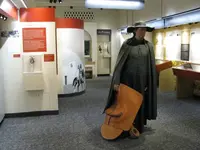Chief among the traditional mines, for the re-discovery of which, the most daring and vigorous of search has been made since the occupation of the Primeria Alta by Americans, is the famous Jesuit mine, known by the name of the Old Mission, whose ruins have been so fully described in these pages—The Tumacacori Mine. Since Charles D. Boston, Herman Ehrenberg and their comrades first located an American mining settlement at the old pueblo of Tubac, six miles from the Tumacacori Mission, there has been more of endeavor, enterprise, daring and courage displayed in the attempt to re-locate this old mine, so famous in the mission annals for its richness, than in all the other efforts made to hold the country against Cochise and his Apachés. Tradition, besides statements of its richness, almost fabulous in character, has left no other indication of its whereabouts than the declaration of one of the mission histrorographers,—that the mine lay directly east of St. Joseph's Church (the Mission of Tumacacori) a morning's walk, or as elsewhere stated, about fourteen miles distant. Recent investigation in the Sierra Santa Rita growing out of the renewed activity induced by the enterprise and speculation, which organized the already successful Aztec Syndicate, and has made this beautifnl mountain range, the last stronghold of the Apaché Napoleon, Cochise—the scene of vigorous exploring efforts, opened numerous mines, established Toltec Camp and aroused a general interest in this region, has also been able to definitely establish the existence and site of the lost Tumacacori mine.
Following the milpas, or secondary mountain bench, from the farm of Joe King in the Santa Cruz valley which embraces the mission ruins) for some eleven miles, the traveler will reach the ruins of the old Hacienda del Santa Rita, where Wrightson, Grosvenor, Hopkins and Slack, lost their lives, and part of the defence of which in 1861, is so graphically described by Professor Raphael Pumpelly, now of Harvard University, in his book ‘‘Across America and Asia.’’ A well defined road evidently long used, and now made quite easy and accessible, is the route from the valley. To the north, Salero Hill looms up boldly, and the explorer in search of the old Tumacacori mine will follow a rough but still good road for a couple of miles to the Salero House, used by the Tyndall Company since 1875. From this point for another mile or so, the explorer will follow a rude bridle path to the Jefferson mine, one of the most valuable of those now worked by the Aztec Syndicate. To the north and east of the Jefferson for less than half a mile, an old mule track, evidently once heavily used, may be traced. It leads directly to a strongly defined lode of the same general character as the Jefferson and Georgia mines, and terminates at what is evidently an old shaft, now filled with debris, and from the mouth of which a vigorous mesquite tree may be seen growing. The evidence is abundant of old workings, and those best informed in the Mexican and Gaqui Indian traditions, like Professor Thomas Davis, who has resided and worked among them for more than a quarter of a century, have no doubt whatever, of the identity of the Bushell, as this location is now termed, with the long-lost site of the famous Tumacacori mine.
The Bushell, or old Tumacacori mine is now being opened, new shafts are being sunk, and the old one already described is to be cleared out at an early day. The ore developments are all excellent. The Saint Louis mine is located on the famous Empress of India lode, in the southern portion of the Aztec district.
The fame of the ‘Bollos de Plata’ (balls of silver) of Arizona in the beginning of the last century was such at the City of Mexico and finally in Spain, that a royal ordinance issued from Madrid, declared the district of Arizona to be royal property as a Criadero de Plata: that is to say, a place where silver was formed in the processes of nature. There is also in existence a royal paper of Philip V. of May 1741, charging among other embezzlements of royal mineral property in Arizona that of a mass of virgin or pure silver weighing two thousand seven hundred pounds.
http://southwest.library.arizona.edu/pict/body.1_div.24.html



 , I'll join you.
, I'll join you. hint.
hint.
 ?
? 
